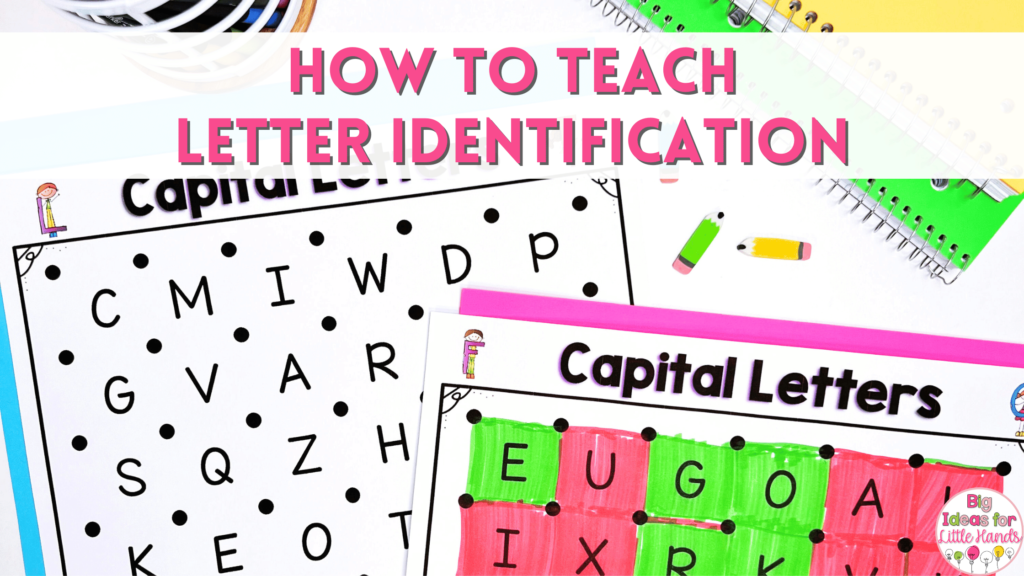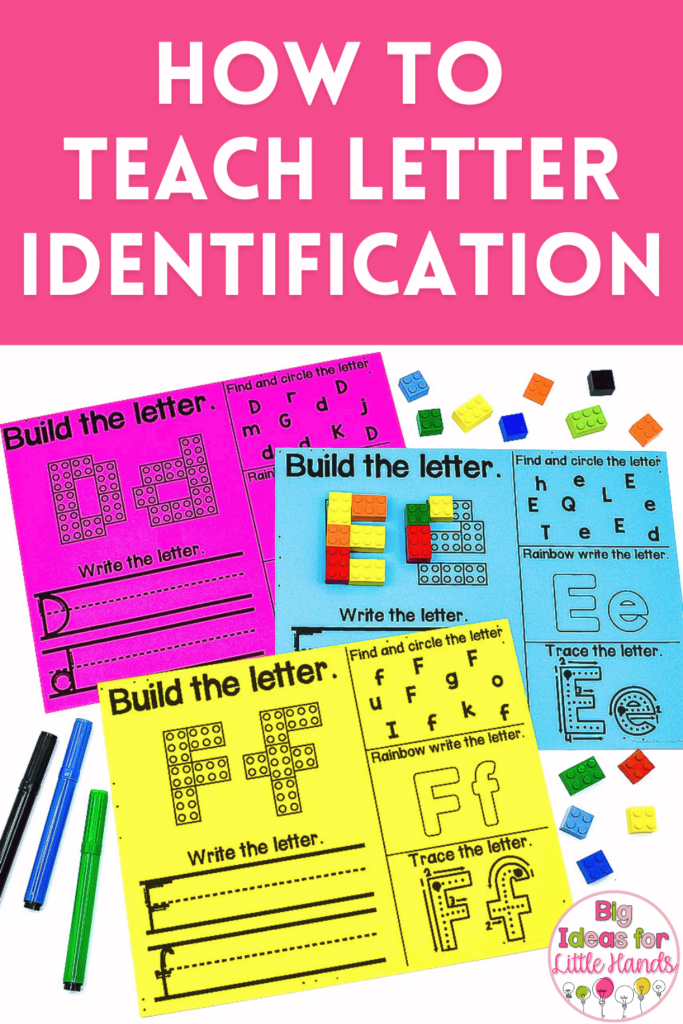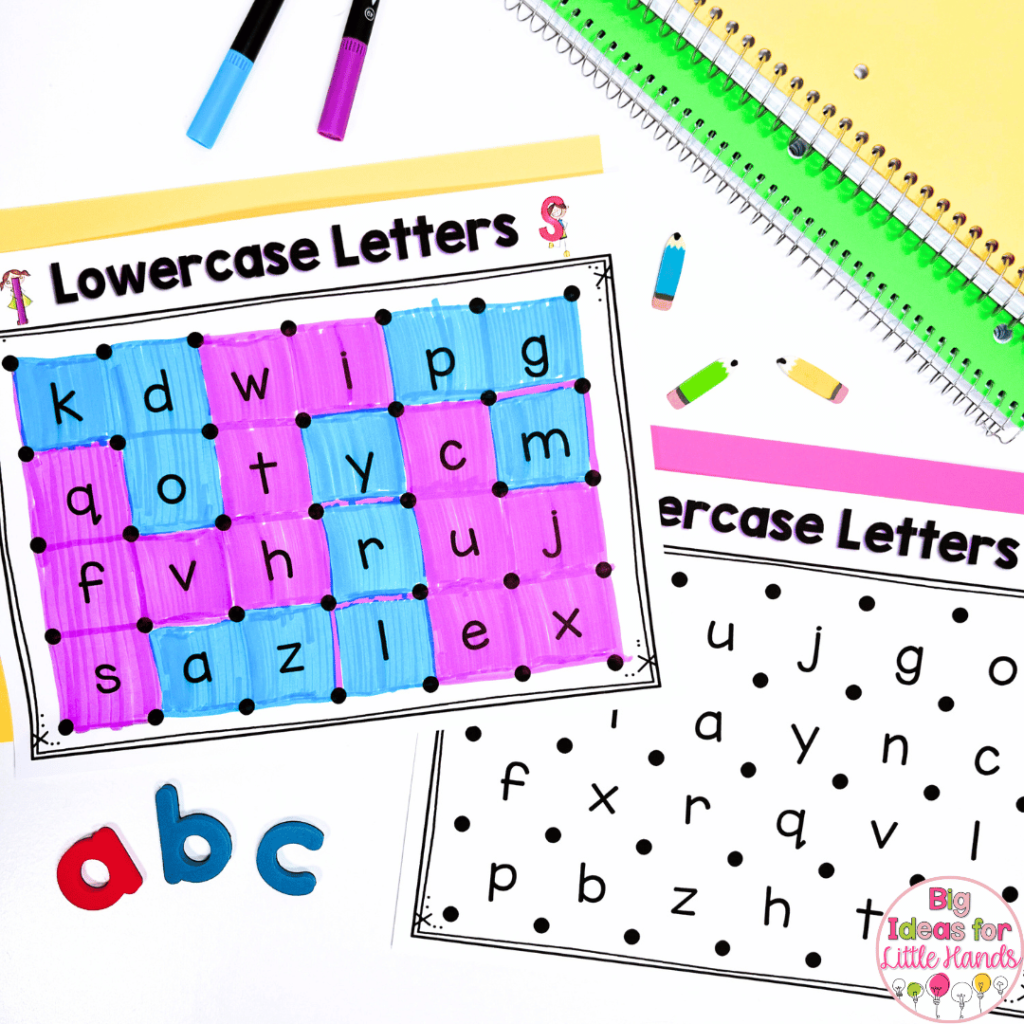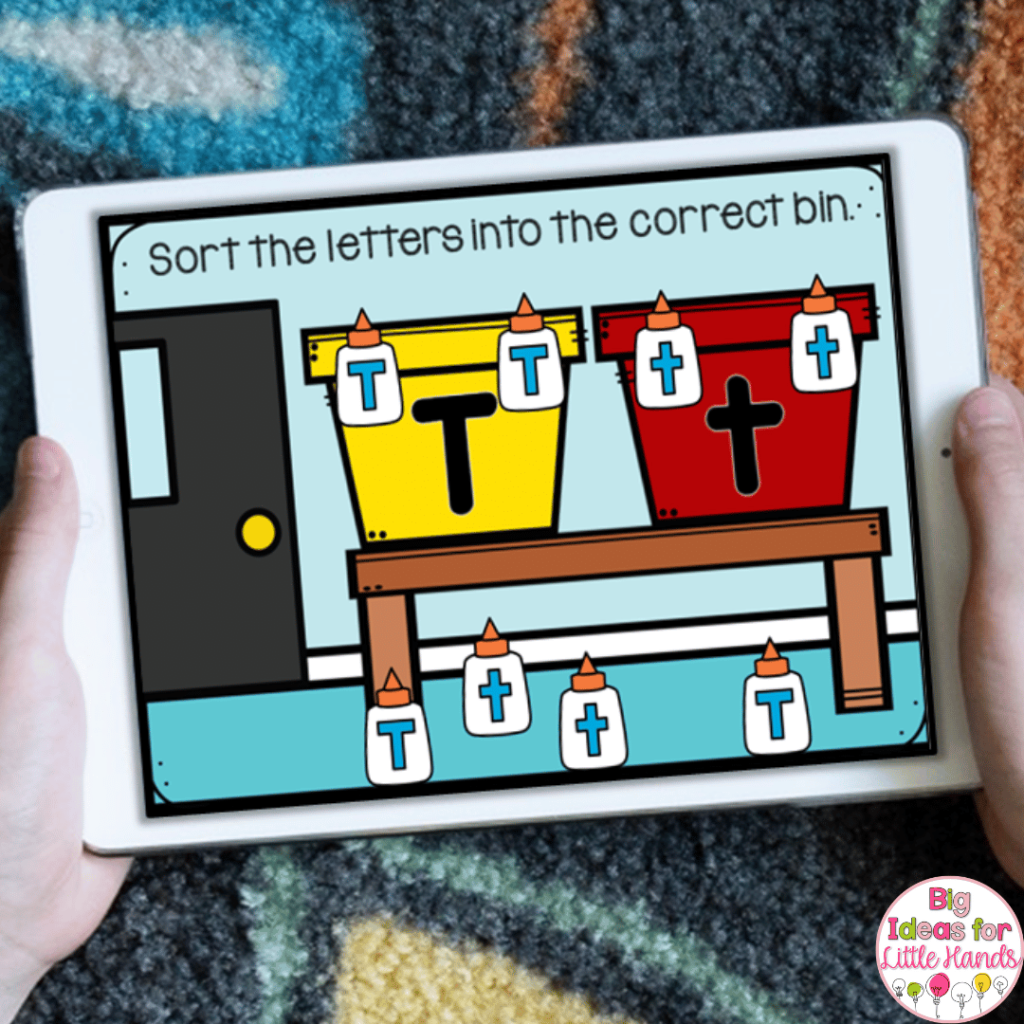Are you gearing up to begin letter identification with your students? If so, you’re in the right place! Today, let’s dive into how to teach letter identification and some of my favorite ways to keep this process fun and engaging all year long!

Teaching Letter Identification
Learning to recognize and correctly identify letters is a key component of phonemic awareness. The goal here is for students to be able to visually see a letter, and say its name and sound instantly. This is often one of the first phonemic awareness skills taught at the preschool and kindergarten levels. It’s an important one too, since knowing letters by name and sound is required for other phonics activities as well!
There are a lot of misconceptions about how to teach letter identification and depending on what school of thought you’re from it can get pretty confusing. I’m here today to dispel some of those myths, clear up confusion, and help you find a way of teaching letter identification that you actually enjoy!
How to Get Started Teaching Letter Identification
The best way to get started is to dive right in! If you’re not sure where to start, here are a few things to keep in mind as you begin to teach letter identification in your own lessons.
Letters Do Not Have To Be Taught In Order
Should letters be taught in order? This is something I hear a lot of from parents. It’s reasonable to assume that letters should be taught in ABC order. But is there actually a benefit to this? I’ve found the answer to be no. In fact, by choosing to focus on letters strategically, you can actually make this process far more valuable to your students!
For example, in my room, we focus on the letters in common CVC words first. This is a strategic choice because it means as soon as my kids master those letters, the sooner we can get started with CVC words. These letters include a, i, p, n, s, and t. Oh and make sure to focus on short vowels first to keep it simple!
With these letters and their sounds mastered, you’ll be able to work with words in the -at, -an, -in, -ip, -ap, families, and more. If kiddos know these letters well, it will be easy to introduce different beginning sounds and form words. Keep in mind though, I teach kindergarten. If you’re in a preschool classroom, you might not be as worried about teaching systematically to align with word families as those are not typically introduced until much later in the year. In this case, a letter-of-the-week approach might suit your needs better! (More on that next!) You may also find that vowels require more time and attention than simple consonants. Mix this up to meet the needs of your students!
How and When to Introduce New Letters
In my classroom, we work with a few letters at a time and really work toward mastery before I start introducing any new letters. I have found over the years that building confidence with just a few letters at a time makes this process far more enjoyable for everyone. The last thing we want is for our students to feel overwhelmed, discouraged, or confused! This is especially important to consider when you are introducing letters that sound or look similar. Try to keep these letters apart in your introductions to avoid confusion!
I like to introduce new letters using digital resources such as Google Slides or Boom Cards. It’s a simple, fun, and interactive way to include my whole group at once! I simply display my slide on the interactive whiteboard and we’re off to the races. These Letter of the Week Google Slides are perfect for introducing new letters to my students and then following up with practice afterward. These come in really handy if you want to spend a full week on each letter. But don’t let the name fool you! Even if you introduce the letters out of order or work on them for less than a week, there are lots of great interactive activities that will help our students learn to recognize their letters.
For each letter, there are 17 slides broken down into 5 days. Students will practice a variety of skills such as sorting letters, building letters, finding letters, and covering letters. Plus, there is a short video or song for each day that is great for whole-group teaching. I love using the specific deck of letter slides and videos each time we start working with a new letter.
Follow-Up Letter Identification Activities
After your digital introduction of each letter, consider taking it a step further with some interactive notebook activities like the ones we use in my room. The idea behind these activities is similar to the ones in the digital, Letter of the Week Slides, so they are the perfect follow-up! After I introduce a new letter, each student gets a set of activities in this resource for that letter. The activities include:
- Sort the letters
- I Spy
- Draw Pictures
- Writing Letters
- Highlight and Trace
- Decorate
- Spin and Write
- Rainbow Color & Write
We work through them as a group and students work on completing, cutting, and gluing them into a notebook. You might choose to focus on a single activity per day or cover a few at once. There are 9 activities included for each letter, so there are plenty of fun and engaging ways to practice with your kids! Not to mention, these notebooks offer a really fun, visual record of all the letters you’ve learned throughout the year!
If you don’t want to do a letter notebook, these activities are also great to use worksheet style. They are perfect for independent practice, morning work or to use as a center.
Spend Time in Small Groups To Teach Letter Identification
My biggest and BEST tip for helping your students master letters is to spend plenty of time working on them in small groups. This is when you’ll be able to clearly see how your students are doing if they are grasping specific letters and sounds, and how you can support them better.
I use a variety of materials in my small groups, but my favorite activities are games. They are perfect for use with just a handful of students at a time and offer a fun and interactive way to teach letter identification. Some of the activities included in my Letter Identification Small Group Games are:
- BINGO
- Thumbs Up/Thumbs Down
- Match It Up
- Fluency Strips
- Roll & Read
- Match & Cover
Many of the activities in this resource include mixed letter practice, so you’ll want to be mindful of that and select activities at the pace your students are ready for them. The key here is to keep it fun and engaging! As students progress, introduce games with more letters to continually challenge your students.
More Ways to Weave Letter Identification Activities into Your Day
Another important thing to keep in mind as you teach letter identification is that you don’t have to use only dedicated lessons to teach new letters. In fact, I think that students learn best when letters are woven into their day as much as possible. Here are a few examples and ways you can do that:
Try a Letter Identification Warm-Up
One of my favorite ways to ensure my students are getting daily practice with our focus letters is to use these “Cover it Up” Worksheets. They are low-prep, easy to use, and FUN for students! Plus, they come in handy when I’m working on getting organized for my next group of kiddos.
I simply lay these worksheets out on the table with small erasers, pom poms or bingo daubers and the students get busy covering the target letter. It is the perfect way to kick off your small group with a letter identification warm-up!
Letter Identification Exit Tickets
Have you ever tried using letter identification activities or challenges as a “ticket” for your kids to line up to leave for the day? This is a fun and exciting way to sneak in a little extra practice every single day. Simply choose a student and tell them you’re looking for a letter that makes a specific sound. Allow them to stand up and search the classroom for the letter that makes that sound, and then say the letter’s name aloud. If they are correct, they get to line up!
Use Hands-On Learning Activities
We all know kids learn best when they’re having fun. In my opinion, the best way to facilitate more fun is by choosing hands-on learning activities whenever possible!
This is also true as you teach letter identification. These Alphabet Pattern Block Activities are a great way to practice building uppercase and lowercase letters. I like to laminate these mats for durability and use them as an option for my morning tubs. Kiddos walk in the door and jump right into practice while we get settled for the day.
Teach Letter Identification with Fun Materials
One of my favorite ways to keep students interested in learning is to use materials that they LOVE! A couple of great examples of this in action are these Building Bricks Mats or these Play Dough Mats. Kiddos love using dough and Lego bricks, so why not incorporate them into learning letters? These options both make a great low-prep center activity as I teach letter identification.
Incorporate Low-Prep Options to Teach Letter Identification
Classroom lesson planning is all about balance, right? What I mean is that we want to ensure we’re choosing a reasonable balance of games and no-prep pages. This serves two purposes. First, it allows you to ensure you’re able to meet your prep requirements and lighten your load a bit. Second, it ensures your students have a wide variety of practice options. Win-win, right? I think so!
My favorite low-prep letter identification activities include these Color by Code Pages and these Make a Square Partner Games. They’re both print and go, making them the perfect option for a last-minute addition to your lesson plan!
Best Methods for Letter Identification Assessment
ESGI Software
Don’t forget about the assessment friends! My favorite method for assessing is ESGI. If you’re someone who’s not a fan of assessing and collecting data- this tool will be your new best friend! The cliff-notes version of this tool is that it’s designed to be fun and interactive for students and takes only minutes to assess. There are two options for kindergarten assessment including one-on-one and self-assessment. You can choose the option that works best for your kiddos.
Once students complete the assessment, the software will generate tons of data for you to view and easily see how each student is doing with specific letter sounds and names. If you’re looking for a simple way to assess and track progress, this is it, friends! You can test it out free by clicking here!
Boom Digital Resources
While ESGI will always have my heart, Boom Cards are another great option for assessment. I like to use these for more informal assessments to use between our ESGI sessions. These are great for just about anyone since you can set up progress tracking on both the website and the app. I find Boom Cards to be especially handy for center time and homework assignments.
Not to mention, Boom Cards are everyone’s favorite activity in my room, making it a no-brainer to include them in my lesson plan. And really, what’s not to love? They’re no-prep, engaging, self-correcting, and fun! I like to sprinkle some activities like these Letter Sorting Cards or these Letter Matching Cards into our classroom centers when we’re focused on letter identification.
Have Fun with Letter Identification in Your Room
We covered a lot here today friends. I hope this post helped you see that teaching letter identification doesn’t have to be crazy complicated or boring. In fact, with a blend of different learning activities, I think you’ll find this process to be really fun! As you begin to teach letter identification in your room, keep one thing in mind… the more fun you make it, the better it will stick! If you want to simplify your planning, be sure to check out all of these resources and many more in my TPT Shop.
Save This Post
Be sure to pin this post on Pinterest to save these ideas on how I teach letter identification in my room.













